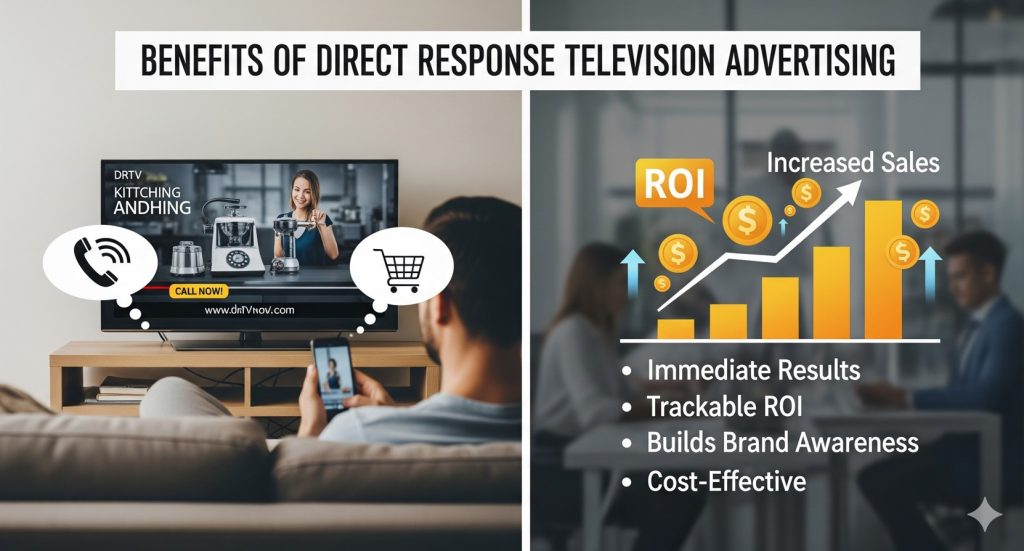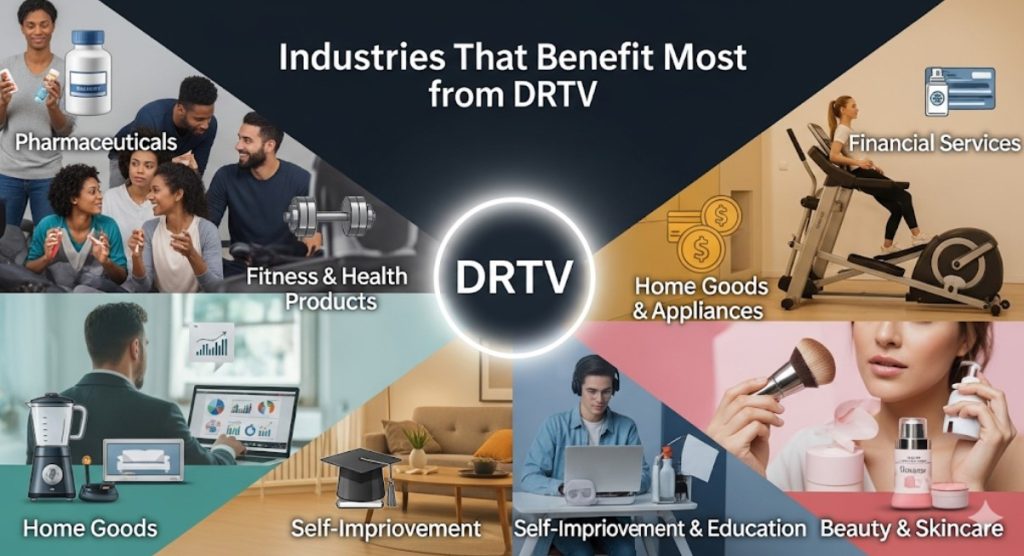Direct response television advertising represents a unique marketing approach that breaks away from traditional brand-building commercials. Unlike standard TV ads that focus on creating awareness and brand recognition over time, direct response television (DRTV) campaigns are designed to generate immediate, measurable action from viewers.
This advertising method transforms your television screen into a direct sales channel, encouraging viewers to pick up the phone, visit a website, or take another specific action right after watching the ad. The key distinguishing factor lies in the immediate call-to-action and the ability to track results directly back to the advertising investment.
DRTV has evolved significantly since its early days of late-night infomercials selling kitchen gadgets and exercise equipment. Modern direct response campaigns span all dayparts and product categories, from insurance and pharmaceuticals to technology services and subscription boxes. The format has proven its effectiveness by generating billions in revenue annually while providing advertisers with unprecedented accountability in their television advertising spend.
How Direct Response Television Advertising Works
The mechanics of DRTV revolve around creating an immediate connection between the advertisement and consumer action. Each commercial includes specific response mechanisms—typically a toll-free phone number, website URL, or text-to-opt-in code—that viewers can use to engage with the advertiser immediately.
Response tracking forms the backbone of successful DRTV campaigns. Advertisers assign unique phone numbers or promo codes to different time slots, channels, and creative executions. This granular tracking enables marketers to determine exactly which placements generate the highest response rates and return on investment.
The creative approach in direct response differs markedly from traditional television advertising. These commercials often feature demonstrations, testimonials, limited-time offers, and multiple calls-to-action throughout the spot. The messaging emphasizes benefits over features, addresses common objections, and creates urgency to drive immediate response.
Media buying strategies also distinguish DRTV from conventional approaches. Rather than purchasing premium programming based on demographic targeting, direct response buyers focus on cost-efficient time slots that deliver strong response rates. This often includes overnight hours, early morning programming, and lower-cost cable networks where competition for airtime remains manageable.

Types of Direct Response Television Formats
Short-Form DRTV
Short-form spots typically run 30, 60, or 120 seconds and fit within standard commercial breaks. These condensed commercials must communicate value propositions quickly while maintaining enough persuasive power to drive immediate action. Industries like insurance, financial services, and consumer products frequently use short-form DRTV to generate leads and direct sales.
The creative challenge in short-form lies in balancing brand messaging with direct response elements. Successful campaigns often feature strong opening hooks, clear benefit statements, social proof through testimonials or endorsements, and prominent contact information displayed throughout the commercial.
Long-Form Infomercials
Infomercials range from 3 to 30 minutes, providing extensive time to educate viewers, demonstrate products, and build compelling cases for purchase. This format works particularly well for complex products requiring detailed explanation or higher-priced items where consumers need more information before making decisions.
Long-form programming allows for comprehensive product demonstrations, multiple testimonials, detailed benefit explanations, and repeated calls-to-action. The extended format also permits addressing common objections and providing various purchasing options to accommodate different consumer preferences.
Branded Content Integration
Some advertisers integrate direct response elements into sponsored content or branded entertainment. This approach combines the engagement value of entertaining programming with direct response mechanics, creating a hybrid format that builds brand affinity while driving measurable actions.
Benefits of Direct Response Television Advertising

Measurable Results and Accountability
DRTV provides immediate feedback on campaign performance through real-time response tracking. Advertisers can monitor call volumes, website traffic, and conversion rates within hours of commercial airings. This immediate measurability enables rapid campaign optimization and budget reallocation toward the highest-performing placements.
Cost-Effective Media Buying
Direct response buyers often secure television advertising inventory at significantly lower rates than traditional advertisers. By focusing on response rates rather than audience demographics, DRTV campaigns can achieve profitable results in time slots that premium advertisers typically avoid.
Scalable Campaign Growth
Successful DRTV campaigns can expand rapidly across multiple markets, channels, and time periods. The performance data from initial tests provides confidence for broader rollouts, enabling businesses to scale winning creative executions efficiently.
Multi-Channel Integration
Modern DRTV campaigns integrate seamlessly with digital marketing efforts. Television advertising drives traffic to websites optimized for conversion, supports social media engagement, and provides content for email marketing follow-up sequences.
Industries That Benefit Most from DRTV

Financial Services
Insurance companies, mortgage lenders, and financial advisors use DRTV extensively to generate qualified leads. The format allows these businesses to explain complex products, build trust through testimonials, and capture contact information from interested prospects.
Health and Wellness
Pharmaceutical companies, supplement manufacturers, and health service providers leverage television advertising to reach specific demographics with targeted messaging. The ability to include detailed disclaimers and safety information makes DRTV particularly suitable for regulated health products.
Home Improvement and Services
Contractors, home security companies, and service providers use direct response formats to generate local leads. These campaigns often feature before-and-after demonstrations, customer testimonials, and limited-time promotional offers.
Consumer Products
From kitchen appliances to personal care items, consumer product companies use DRTV to demonstrate product benefits, share customer experiences, and drive direct sales through multiple channels.
Common Challenges and Solutions
Creative Fatigue and Wear-Out
DRTV commercials typically air frequently across multiple time slots, leading to creative fatigue as audiences become familiar with the messaging. Successful campaigns combat this challenge by developing multiple creative executions, rotating testimonials, and updating offers periodically.
Media Cost Management
While DRTV often provides cost-effective advertising opportunities, successful campaigns require careful media buying and continuous optimization. Advertisers must balance reach and frequency against response rates to maintain profitability.
Lead Quality and Follow-Up
Generating responses represents only the first step in the DRTV process. Advertisers must implement effective lead qualification, nurturing, and conversion systems to maximize campaign return on investment.
Measuring DRTV Success
Effective measurement extends beyond initial response rates to include lifetime customer value, conversion rates, and overall campaign profitability. Key performance indicators include:
- Cost per response
- Conversion rate from inquiry to sale
- Average order value
- Customer lifetime value
- Return on advertising spend (ROAS)
Advanced attribution modeling helps advertisers understand how television advertising influences customer behavior across multiple touchpoints, providing a comprehensive view of campaign effectiveness.
Getting Started with Direct Response Television
DRTV success requires careful planning, creative development, and systematic testing. Begin with clear objectives, whether lead generation, direct sales, or brand building, with measurable outcomes. Develop creative concepts that communicate value propositions clearly while incorporating strong calls-to-action.
Start with limited market testing to validate creative concepts and media strategies before expanding to broader campaigns. Monitor response rates closely and optimize media placements based on performance data.
Partner with experienced DRTV agencies or consultants who understand the unique requirements of direct response campaigns. Their expertise in creative development, media buying, and campaign optimization can significantly impact results.
The Future of Direct Response Television
Direct response television advertising continues evolving alongside changing viewer behaviors and technological advances. Connected TV and streaming platforms offer new opportunities for targeted direct response campaigns with enhanced measurement capabilities.
Interactive features, shoppable TV ads, and seamless integration with mobile devices create new possibilities for immediate consumer engagement. Smart TV platforms enable more sophisticated audience targeting while maintaining the immediate response capabilities that define effective DRTV campaigns.
Despite changes in viewing habits, television remains a powerful medium for driving immediate consumer action. The combination of sight, sound, and motion creates emotional connections that translate into measurable business results for advertisers who understand how to leverage this unique advertising format effectively.





